BTEC Level 4 HND Diploma in Business: HRM Report on McDonald's
VerifiedAdded on 2021/10/04
|32
|10503
|143
Report
AI Summary
This report provides a detailed analysis of Human Resource Management (HRM) within McDonald's. It begins with an introduction to McDonald's, its mission, and vision, emphasizing the crucial role of HRM in its success. The report defines HRM, outlining its purpose, key roles, and objectives, including administrative, operational, and strategic functions. It explores the importance of HRM in organizational, social, and professional contexts, as well as the philosophy behind HRM, including resource dependence and organizational behavior theories. The core of the report focuses on key HRM functions, such as workforce planning, recruitment and selection, training and development, performance management, and reward management, with specific examples related to McDonald's practices. The report concludes with a summary of the findings and references to the sources used.

ASSIGNMENT 1 FRONT SHEET
Qualification BTEC Level 4 HND Diploma in Business
Unit number and title Unit 3: Human resource management
Submission date Date Received 1st submissio
Re-submission Date Date Received 2nd submiss
Group number:
Student names & codes Final scores
1. Le Hai Minh
2. Dinh Quang Minh
3. Tran Tuyet Nhi
4. Nguyen Viet Duy
Class Assessor name
Student declaration
I certify that the assignment submission is entirely my own work and I fully understand the consequences of pla
false declaration is a form of malpractice.
P1 P2 P3 P4 M1 M2 M3
Qualification BTEC Level 4 HND Diploma in Business
Unit number and title Unit 3: Human resource management
Submission date Date Received 1st submissio
Re-submission Date Date Received 2nd submiss
Group number:
Student names & codes Final scores
1. Le Hai Minh
2. Dinh Quang Minh
3. Tran Tuyet Nhi
4. Nguyen Viet Duy
Class Assessor name
Student declaration
I certify that the assignment submission is entirely my own work and I fully understand the consequences of pla
false declaration is a form of malpractice.
P1 P2 P3 P4 M1 M2 M3
Paraphrase This Document
Need a fresh take? Get an instant paraphrase of this document with our AI Paraphraser
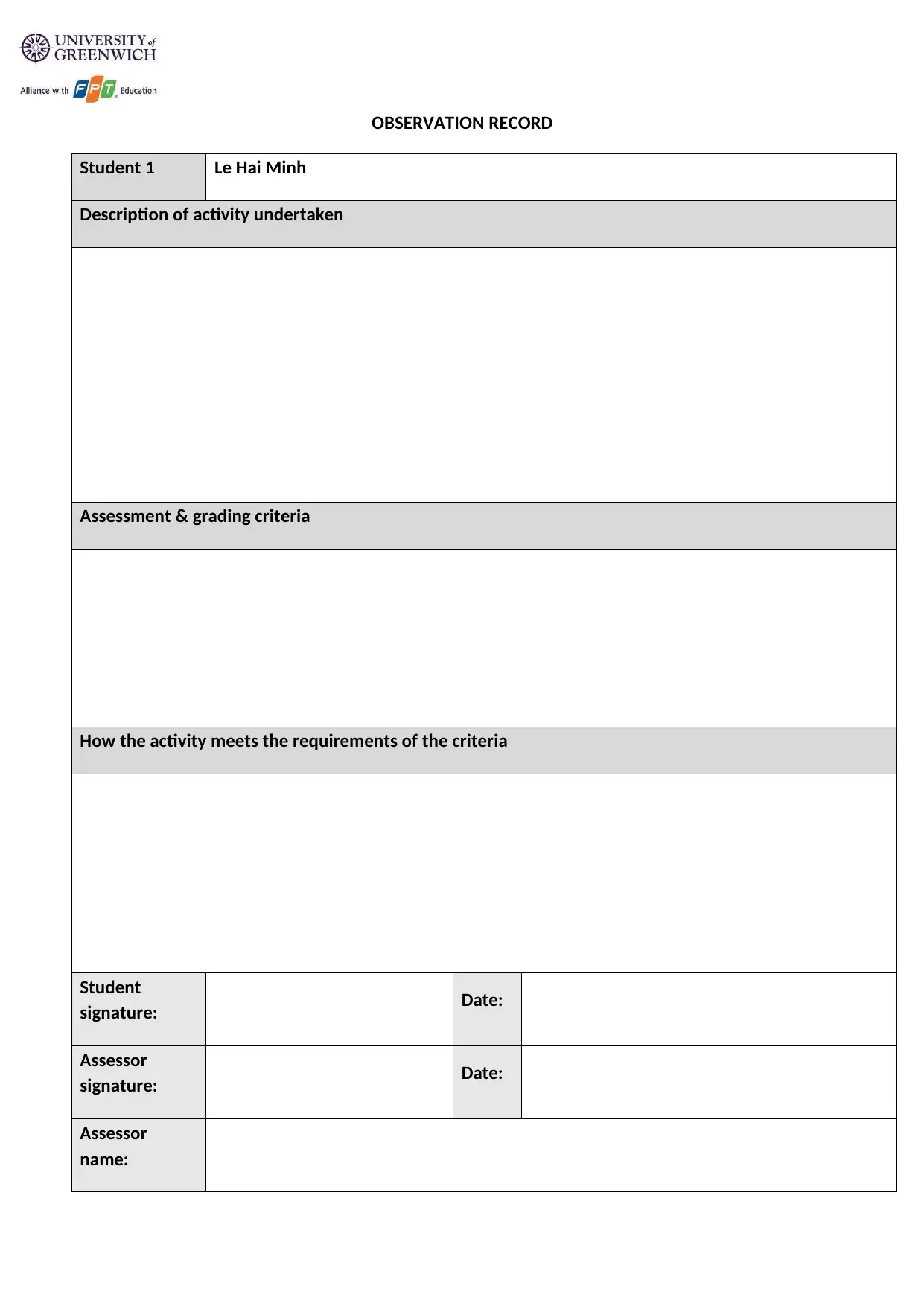
OBSERVATION RECORD
Student 1 Le Hai Minh
Description of activity undertaken
Assessment & grading criteria
How the activity meets the requirements of the criteria
Student
signature: Date:
Assessor
signature: Date:
Assessor
name:
Student 1 Le Hai Minh
Description of activity undertaken
Assessment & grading criteria
How the activity meets the requirements of the criteria
Student
signature: Date:
Assessor
signature: Date:
Assessor
name:

Student 2 Dinh Quang Minh
Description of activity undertaken
Assessment & grading criteria
How the activity meets the requirements of the criteria
Student
signature: Date:
Assessor
signature: Date:
Assessor
name:
Description of activity undertaken
Assessment & grading criteria
How the activity meets the requirements of the criteria
Student
signature: Date:
Assessor
signature: Date:
Assessor
name:
⊘ This is a preview!⊘
Do you want full access?
Subscribe today to unlock all pages.

Trusted by 1+ million students worldwide
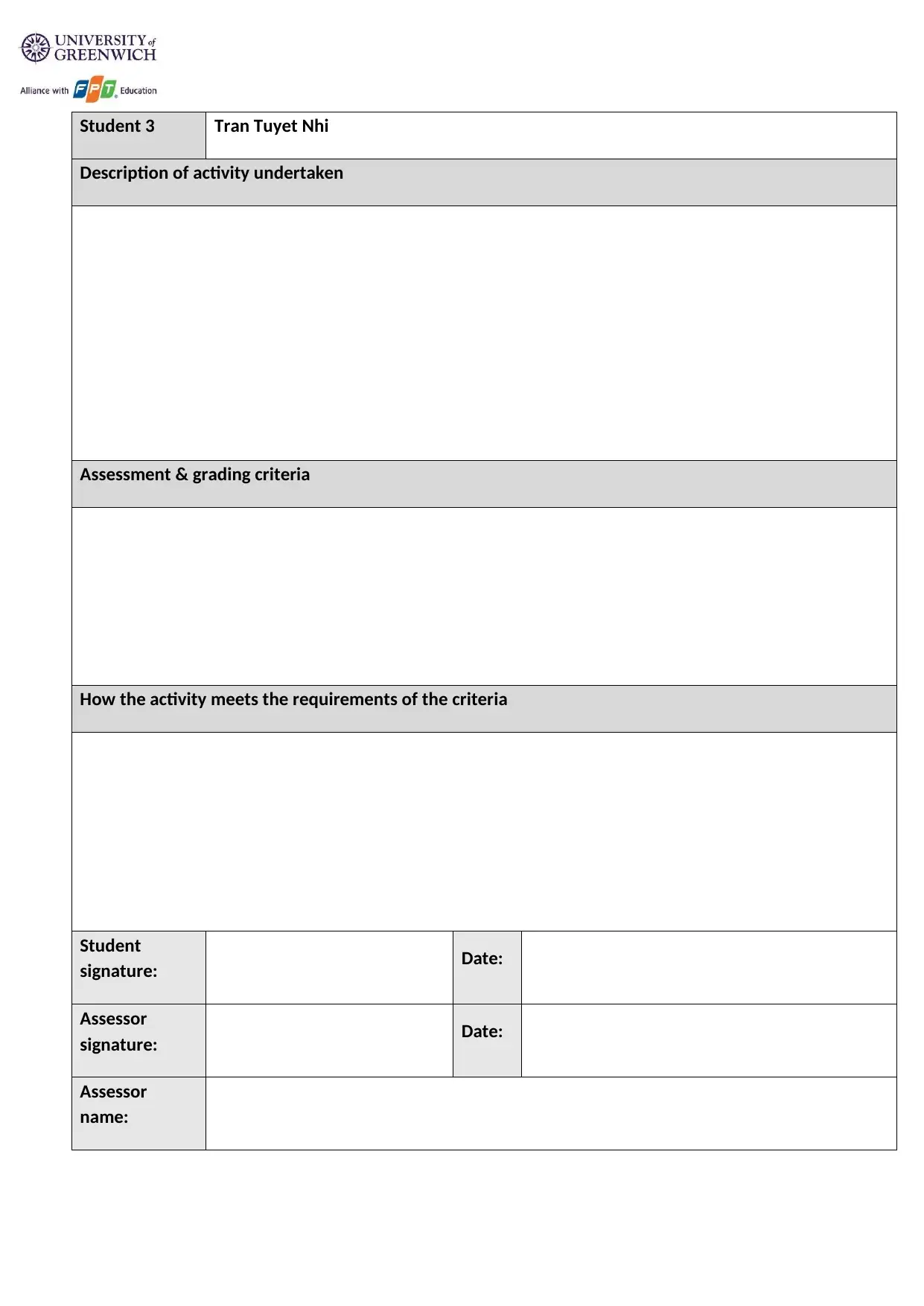
Student 3 Tran Tuyet Nhi
Description of activity undertaken
Assessment & grading criteria
How the activity meets the requirements of the criteria
Student
signature: Date:
Assessor
signature: Date:
Assessor
name:
Description of activity undertaken
Assessment & grading criteria
How the activity meets the requirements of the criteria
Student
signature: Date:
Assessor
signature: Date:
Assessor
name:
Paraphrase This Document
Need a fresh take? Get an instant paraphrase of this document with our AI Paraphraser
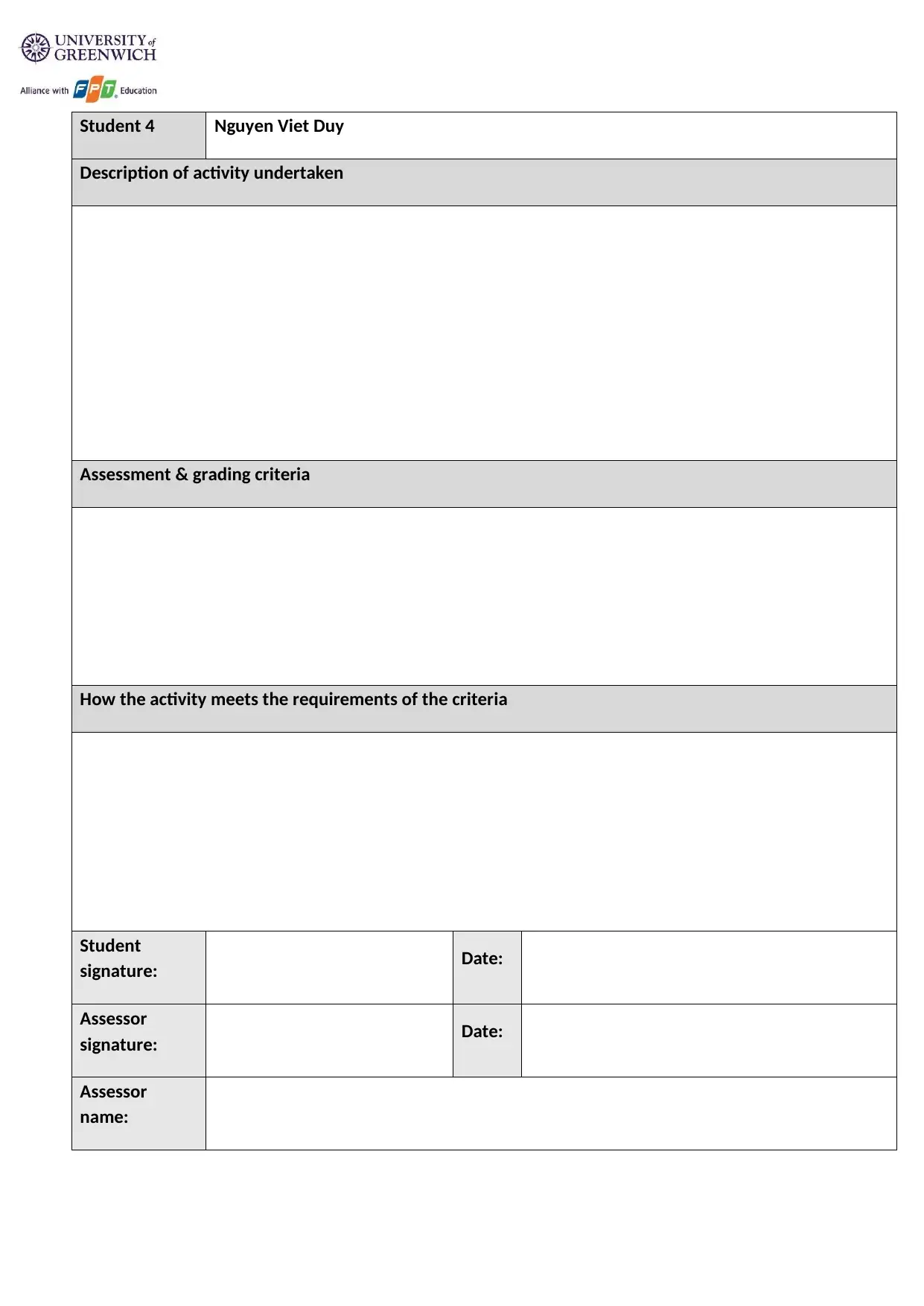
Student 4 Nguyen Viet Duy
Description of activity undertaken
Assessment & grading criteria
How the activity meets the requirements of the criteria
Student
signature: Date:
Assessor
signature: Date:
Assessor
name:
Description of activity undertaken
Assessment & grading criteria
How the activity meets the requirements of the criteria
Student
signature: Date:
Assessor
signature: Date:
Assessor
name:
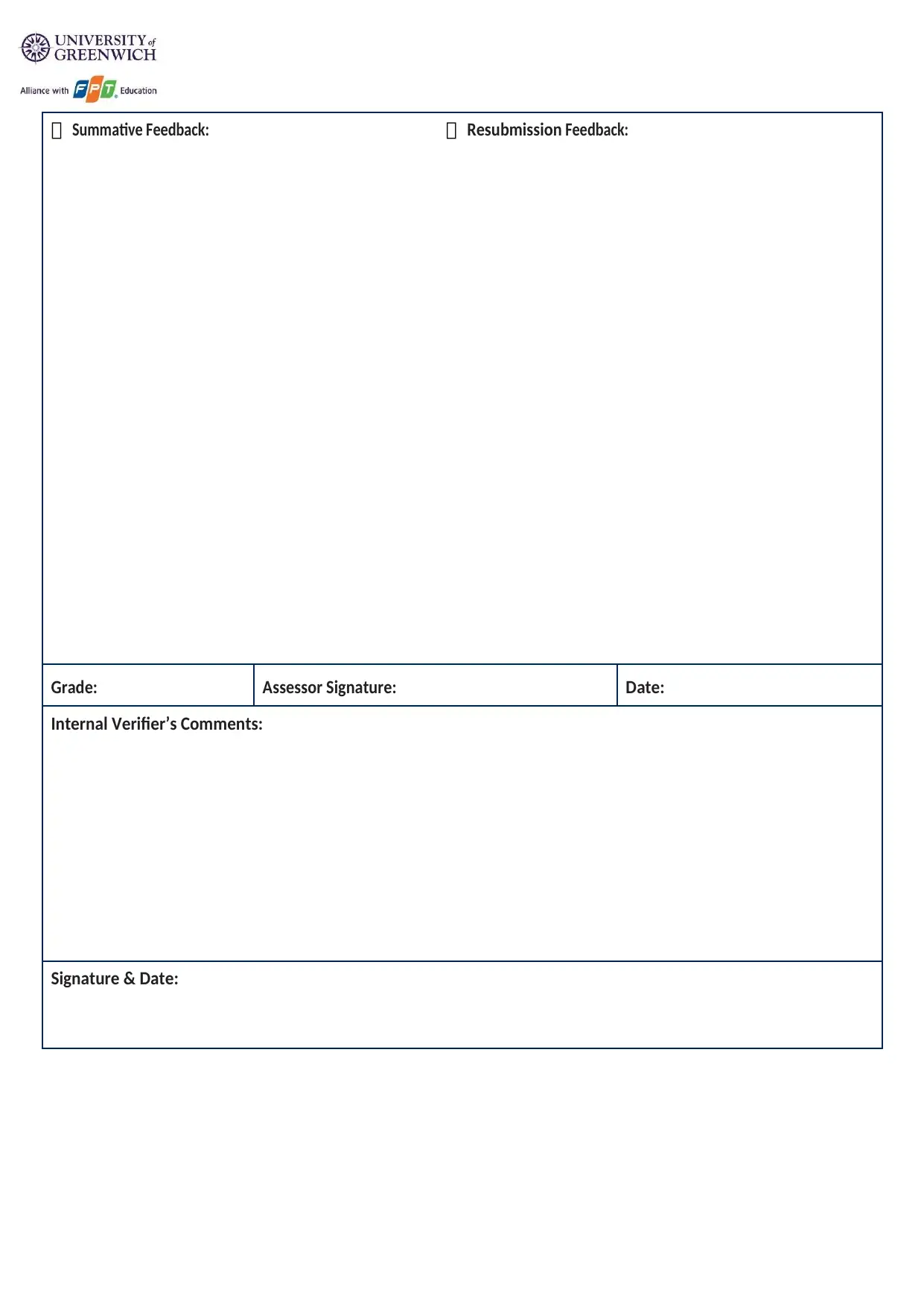
Summative Feedback: Resubmission Feedback:
Grade: Assessor Signature: Date:
Internal Verifier’s Comments:
Signature & Date:
Grade: Assessor Signature: Date:
Internal Verifier’s Comments:
Signature & Date:
⊘ This is a preview!⊘
Do you want full access?
Subscribe today to unlock all pages.

Trusted by 1+ million students worldwide

Table of Contents
I. INTRODUCTION ............................................................................................................................................... 8
II. PURPOSE, KEY ROLES AND RESPONSIBILITY OF HRM FUNCTION ...................................................................... 9
A. WHAT IS HRM? ............................................................................................................................................ 9
B. ROLE OF HRM .............................................................................................................................................. 9
C. GOAL OF HRM ............................................................................................................................................. 9
D. IMPORTANCE OF HMR ............................................................................................................................... 10
E. THE OBJECTIVES OF HRM ........................................................................................................................... 10
F. PHILOSOPHY OF HRM ................................................................................................................................ 12
III. KEY HRM RESOURCE FUNCTIONS ................................................................................................................... 12
A. WORKFORCE PLANNING ............................................................................................................................ 12
B. RECRUITMENT AND SELECTION ................................................................................................................. 16
C. TRAINING AND DEVELOPMENT .................................................................................................................. 22
D. PERFORMANCE MANAGEMENT ................................................................................................................. 24
E. REWARD MANAGEMENT ........................................................................................................................... 27
IV. CONCLUTION ................................................................................................................................................. 29
REFERENCES .......................................................................................................................................................... 29
I. INTRODUCTION ............................................................................................................................................... 8
II. PURPOSE, KEY ROLES AND RESPONSIBILITY OF HRM FUNCTION ...................................................................... 9
A. WHAT IS HRM? ............................................................................................................................................ 9
B. ROLE OF HRM .............................................................................................................................................. 9
C. GOAL OF HRM ............................................................................................................................................. 9
D. IMPORTANCE OF HMR ............................................................................................................................... 10
E. THE OBJECTIVES OF HRM ........................................................................................................................... 10
F. PHILOSOPHY OF HRM ................................................................................................................................ 12
III. KEY HRM RESOURCE FUNCTIONS ................................................................................................................... 12
A. WORKFORCE PLANNING ............................................................................................................................ 12
B. RECRUITMENT AND SELECTION ................................................................................................................. 16
C. TRAINING AND DEVELOPMENT .................................................................................................................. 22
D. PERFORMANCE MANAGEMENT ................................................................................................................. 24
E. REWARD MANAGEMENT ........................................................................................................................... 27
IV. CONCLUTION ................................................................................................................................................. 29
REFERENCES .......................................................................................................................................................... 29
Paraphrase This Document
Need a fresh take? Get an instant paraphrase of this document with our AI Paraphraser

I. INTRODUCTION
MCDonalds Corporate
Establish: May 15, 1940
Founder: Richard and Maurice McDonald
Headquarters: Oak Brook , Illinois , USA
Number of headquarters: 36,000+ (global)
Product: Fast food
Website: McDonalds.com
McDonald's is a fast-food restaurant chain with about 36,000 restaurants in 119 countries serving 43
million visitors a day under its own brand name. The company was founded in 1940 by the brothers Richard
and Maurice ("Mick & Mack") McDonald. The foundation of today's successful business was acquired by
Ray Kroc of the McDonald's brothers and developed into one of the most successful fast food business in
the world. Mission of Mc Donald is to be the customer’s favorite place to eat and drink (Kempczinski, 2019).
The company's effort is to provide special experiences for customers worldwide. It also aims to develop
profitable business while increasing the development of the community (McDonalds Steel, 2019). Mc
Donald's vision is to become the best fast food restaurant in the world. Best includes providing quality
service, dishes with nutritional value and high cleanliness, from which every customer comes to experience
smiling when returning (McDonalds Steel, 2019). In order to achieve this success, the company's HRM
MCDonalds Corporate
Establish: May 15, 1940
Founder: Richard and Maurice McDonald
Headquarters: Oak Brook , Illinois , USA
Number of headquarters: 36,000+ (global)
Product: Fast food
Website: McDonalds.com
McDonald's is a fast-food restaurant chain with about 36,000 restaurants in 119 countries serving 43
million visitors a day under its own brand name. The company was founded in 1940 by the brothers Richard
and Maurice ("Mick & Mack") McDonald. The foundation of today's successful business was acquired by
Ray Kroc of the McDonald's brothers and developed into one of the most successful fast food business in
the world. Mission of Mc Donald is to be the customer’s favorite place to eat and drink (Kempczinski, 2019).
The company's effort is to provide special experiences for customers worldwide. It also aims to develop
profitable business while increasing the development of the community (McDonalds Steel, 2019). Mc
Donald's vision is to become the best fast food restaurant in the world. Best includes providing quality
service, dishes with nutritional value and high cleanliness, from which every customer comes to experience
smiling when returning (McDonalds Steel, 2019). In order to achieve this success, the company's HRM

team has played an extremely important role in the company's development and in this report will
highlight the role and importance of HRM in the company.
II. PURPOSE, KEY ROLES AND RESPONSIBILITY OF HRM FUNCTION
A. WHAT IS HRM?
Human Resource Management is the process of recruiting, selecting, inducting employees, providing
orientation, imparting training and development, appraising the performance of employees, deciding
compensation and providing benefits, motivating employees, maintaining proper relations with employees
and their trade unions, ensuring employees safety, welfare and health measures in compliance with labor
laws of the land (Whatishumanresource.com, 2019).
B. ROLE OF HRM
Administrative
Clerical administration, recordkeeping, legal paperwork and policy implementation
Major shifts - Use of technology and outsourcing
Operational and Employee Advocate
Cooperate with managers and supervisors
Identify and implement needed programs and policies in the organization
Strategic
Address business realities
Focus on future business needs
Fit between human capital and business plans and needs (Coursehero.com, 2019)
C. GOAL OF HRM
The goals of HRM are to: Support the organization in achieving its objectives by developing and
implementing human resource (HR) strategies that are integrated with the business strategy (strategic
highlight the role and importance of HRM in the company.
II. PURPOSE, KEY ROLES AND RESPONSIBILITY OF HRM FUNCTION
A. WHAT IS HRM?
Human Resource Management is the process of recruiting, selecting, inducting employees, providing
orientation, imparting training and development, appraising the performance of employees, deciding
compensation and providing benefits, motivating employees, maintaining proper relations with employees
and their trade unions, ensuring employees safety, welfare and health measures in compliance with labor
laws of the land (Whatishumanresource.com, 2019).
B. ROLE OF HRM
Administrative
Clerical administration, recordkeeping, legal paperwork and policy implementation
Major shifts - Use of technology and outsourcing
Operational and Employee Advocate
Cooperate with managers and supervisors
Identify and implement needed programs and policies in the organization
Strategic
Address business realities
Focus on future business needs
Fit between human capital and business plans and needs (Coursehero.com, 2019)
C. GOAL OF HRM
The goals of HRM are to: Support the organization in achieving its objectives by developing and
implementing human resource (HR) strategies that are integrated with the business strategy (strategic
⊘ This is a preview!⊘
Do you want full access?
Subscribe today to unlock all pages.

Trusted by 1+ million students worldwide
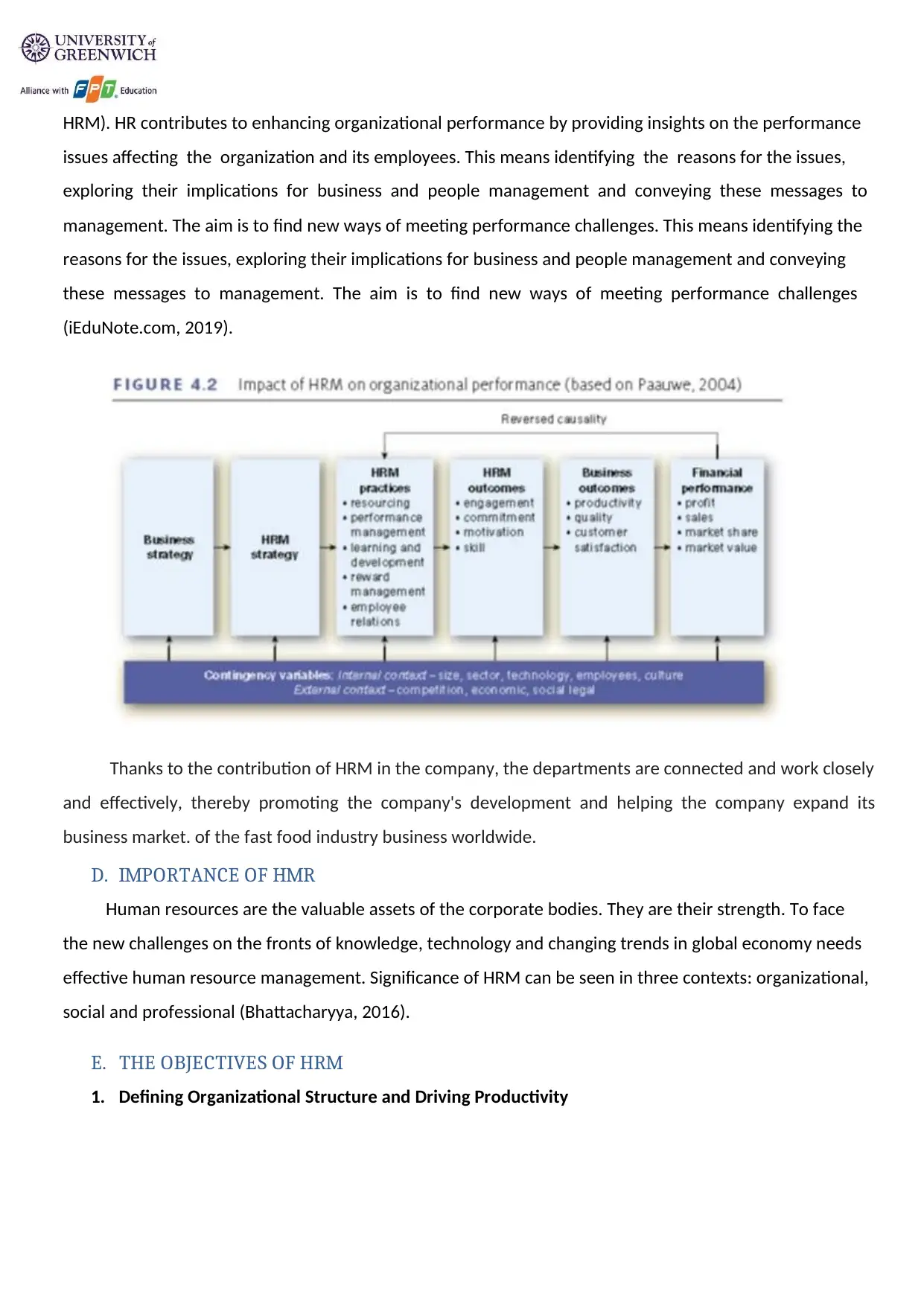
HRM). HR contributes to enhancing organizational performance by providing insights on the performance
issues affecting the organization and its employees. This means identifying the reasons for the issues,
exploring their implications for business and people management and conveying these messages to
management. The aim is to find new ways of meeting performance challenges. This means identifying the
reasons for the issues, exploring their implications for business and people management and conveying
these messages to management. The aim is to find new ways of meeting performance challenges
(iEduNote.com, 2019).
Thanks to the contribution of HRM in the company, the departments are connected and work closely
and effectively, thereby promoting the company's development and helping the company expand its
business market. of the fast food industry business worldwide.
D. IMPORTANCE OF HMR
Human resources are the valuable assets of the corporate bodies. They are their strength. To face
the new challenges on the fronts of knowledge, technology and changing trends in global economy needs
effective human resource management. Significance of HRM can be seen in three contexts: organizational,
social and professional (Bhattacharyya, 2016).
E. THE OBJECTIVES OF HRM
1. Defining Organizational Structure and Driving Productivity
issues affecting the organization and its employees. This means identifying the reasons for the issues,
exploring their implications for business and people management and conveying these messages to
management. The aim is to find new ways of meeting performance challenges. This means identifying the
reasons for the issues, exploring their implications for business and people management and conveying
these messages to management. The aim is to find new ways of meeting performance challenges
(iEduNote.com, 2019).
Thanks to the contribution of HRM in the company, the departments are connected and work closely
and effectively, thereby promoting the company's development and helping the company expand its
business market. of the fast food industry business worldwide.
D. IMPORTANCE OF HMR
Human resources are the valuable assets of the corporate bodies. They are their strength. To face
the new challenges on the fronts of knowledge, technology and changing trends in global economy needs
effective human resource management. Significance of HRM can be seen in three contexts: organizational,
social and professional (Bhattacharyya, 2016).
E. THE OBJECTIVES OF HRM
1. Defining Organizational Structure and Driving Productivity
Paraphrase This Document
Need a fresh take? Get an instant paraphrase of this document with our AI Paraphraser

Human Resource Management is a method to realize competence and drive efficiency in
organizational work. Therefore, its chief determination remains in accomplishing organizational goals. It
has to benefit organizations by outlining clearly defined aims and achieving them.
Apart from meeting the organizational goals, Human Resource Management also describes the key
problems to be taken care of and governs rules and urgencies. It engenders organizational efficacy, by
hiring efficient people, training them and effectively employing the workers.
It should also develop the service that organization provides to the society through structuring
employee confidence in a positive direction, which is at the front of effectual individual and group
performance (Bhattacharyya, 2016).
2. Building Coordination Between Organizational Departments
Human Resource Management is responsible for coordination and harmonious functionality within,
and between different departments. The resources are organized to achieve business objectives. Also, it is
to be made certain that there is functional utilization and all-out growth of human resources.
Human Resource Management should aim at making effective use of the workforce through proper
direction of the organizational sectors. This includes refining the conditions for successful outcomes, by
making appropriate decisions about human resource planning, recruitment, evaluation, rewards, training
and improvement and staff associations that are reliable and sustain the business strategy (Bhattacharyya,
2016).
3. Offering Employee Satisfaction
It has become harder than ever for companies to hire and sustain capable people because of the
rising global competition. Add to it, the lack of sufficiently skilled personnel. As such, it becomes an
undeniable priority for Human Resource Management to hire and train the right talent.
It should be ensured that there is an environment of respect among people in the organization, and
individual needs are catered to. The HR strategies, policies and ideas for individual improvement must be
cohesive with the organization’s strategic goals.
organizational work. Therefore, its chief determination remains in accomplishing organizational goals. It
has to benefit organizations by outlining clearly defined aims and achieving them.
Apart from meeting the organizational goals, Human Resource Management also describes the key
problems to be taken care of and governs rules and urgencies. It engenders organizational efficacy, by
hiring efficient people, training them and effectively employing the workers.
It should also develop the service that organization provides to the society through structuring
employee confidence in a positive direction, which is at the front of effectual individual and group
performance (Bhattacharyya, 2016).
2. Building Coordination Between Organizational Departments
Human Resource Management is responsible for coordination and harmonious functionality within,
and between different departments. The resources are organized to achieve business objectives. Also, it is
to be made certain that there is functional utilization and all-out growth of human resources.
Human Resource Management should aim at making effective use of the workforce through proper
direction of the organizational sectors. This includes refining the conditions for successful outcomes, by
making appropriate decisions about human resource planning, recruitment, evaluation, rewards, training
and improvement and staff associations that are reliable and sustain the business strategy (Bhattacharyya,
2016).
3. Offering Employee Satisfaction
It has become harder than ever for companies to hire and sustain capable people because of the
rising global competition. Add to it, the lack of sufficiently skilled personnel. As such, it becomes an
undeniable priority for Human Resource Management to hire and train the right talent.
It should be ensured that there is an environment of respect among people in the organization, and
individual needs are catered to. The HR strategies, policies and ideas for individual improvement must be
cohesive with the organization’s strategic goals.

It should gratify individual objectives of employees so that personal and organizational objectives can
be aligned, conducive to reaching maximum productivity and establishing a certain competitive edge
(Bhattacharyya, 2016).
4. Keeping Up with The Societal And Ethical Models
It must be the responsibility of Human Resource management to ensure that legal, ethical, and social
environmental issues are suitably dealt with. It must make sure that the human resources are officially and
compliantly coped with and their requirements are recognized and fulfilled. It should also consider the
societal ethics and undertake social responsibility.
It must also try to enhance organization’s competitive advantage through social strategies, by
pitching in ethically to the necessities and challenges evolving in the society. The societal objectives also
involve legal issues such as equal opportunity and equal pay, which should be given due concern
(Bhattacharyya, 2016).
F. PHILOSOPHY OF HRM
Human resource policies should be integrated with strategic business planning and used to reinforce
an appropriate (or change an inappropriate) organizational culture, that human resources are valuable and
a source of competitive advantage, that they may be tapped most effectively by mutually consistent
policies that promote commitment and which, as a consequence, foster a willingness in employees to act
flexibly in the interests of the ‘adaptive organization’s’ pursuit of excellence. Resource dependence theory
states that groups and organizations gain power over each other by controlling valued resources. HRM
activities are assumed to reflect the distribution of power in the system. In the other side, organizational
behavior theory describes how people within their organizations act individually or in groups and how
organizations function in terms of their structure, processes and culture. It therefore influences HRM
approaches to organization design and development and enhancing organizational capability (the capacity
of an organization to function effectively in order to achieve desired results) (Sabry, 2019).
III. KEY HRM RESOURCE FUNCTIONS
A. WORKFORCE PLANNING
Workforce planning refers to the process of ensuring an organization has current and future access
to the human resources they need to perform effectively. Strategic workforce planning is to plan the
be aligned, conducive to reaching maximum productivity and establishing a certain competitive edge
(Bhattacharyya, 2016).
4. Keeping Up with The Societal And Ethical Models
It must be the responsibility of Human Resource management to ensure that legal, ethical, and social
environmental issues are suitably dealt with. It must make sure that the human resources are officially and
compliantly coped with and their requirements are recognized and fulfilled. It should also consider the
societal ethics and undertake social responsibility.
It must also try to enhance organization’s competitive advantage through social strategies, by
pitching in ethically to the necessities and challenges evolving in the society. The societal objectives also
involve legal issues such as equal opportunity and equal pay, which should be given due concern
(Bhattacharyya, 2016).
F. PHILOSOPHY OF HRM
Human resource policies should be integrated with strategic business planning and used to reinforce
an appropriate (or change an inappropriate) organizational culture, that human resources are valuable and
a source of competitive advantage, that they may be tapped most effectively by mutually consistent
policies that promote commitment and which, as a consequence, foster a willingness in employees to act
flexibly in the interests of the ‘adaptive organization’s’ pursuit of excellence. Resource dependence theory
states that groups and organizations gain power over each other by controlling valued resources. HRM
activities are assumed to reflect the distribution of power in the system. In the other side, organizational
behavior theory describes how people within their organizations act individually or in groups and how
organizations function in terms of their structure, processes and culture. It therefore influences HRM
approaches to organization design and development and enhancing organizational capability (the capacity
of an organization to function effectively in order to achieve desired results) (Sabry, 2019).
III. KEY HRM RESOURCE FUNCTIONS
A. WORKFORCE PLANNING
Workforce planning refers to the process of ensuring an organization has current and future access
to the human resources they need to perform effectively. Strategic workforce planning is to plan the
⊘ This is a preview!⊘
Do you want full access?
Subscribe today to unlock all pages.

Trusted by 1+ million students worldwide
1 out of 32
Related Documents
Your All-in-One AI-Powered Toolkit for Academic Success.
+13062052269
info@desklib.com
Available 24*7 on WhatsApp / Email
![[object Object]](/_next/static/media/star-bottom.7253800d.svg)
Unlock your academic potential
Copyright © 2020–2025 A2Z Services. All Rights Reserved. Developed and managed by ZUCOL.





